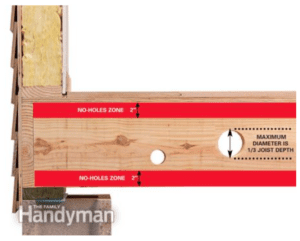How to correctly position holes in floor joists so they don’t weaken the joist.
You can safely drill joists for electrical and plumbing runs without weakening the joists, if you follow the rules. By the DIY experts of The Family Handyman Magazine.
Where and how to drill joists for electrical cables or plumbing runs depends on what type of floor framing you have.
Keep the hole at least 2 in. from the top and the bottom if it’s a dimensional lumber joist. The hole cannot be larger than one-third the depth of the joist, so the maximum hole size for a 2×12 joist (actual size 1-1/2 x 11-1/4 in.) is 3-3/4 in. diameter—plenty big enough for running cable! You can drill the holes anywhere along the length of the joist (first photo).
If you have manufactured I-joists, you can drill holes up to 1-1/2 in. diameter almost anywhere in the web area (the area between the flanges). Just stay 6 in. away from any end or load-bearing wall (second photo).
Holes up to 4 in. can be drilled in the middle of the I-joist, away from the ends and load-bearing wall. Keep the distance between adjacent holes at least twice the diameter of the largest hole. For holes larger than 4 in., consult the lumber supplier.
Where to safely drill holes in a floor joist:
Dimensional Lumber
Engineered Lumber
Drill 1-1/2-in. holes anywhere in the web area of engineered I-joists, except within 6 in. of walls and rim joists.
We always recommend that you refer to the manufacturer’s instructions for the best, most up-to-date and brand-specific requirements.
See our selection of engineered lumber at both our Lakewood and Fort Lupton lumberyards.
We sell a complete selection of Glulams, LVLs, LSLs, I-Joists, Parallams, Rimboards and more. Read our comprehensive information on Engineered Wood.







